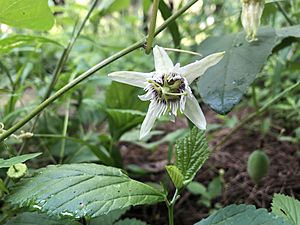Cupped passionflower facts for kids
Quick facts for kids Cupped passionflower |
|
|---|---|
 |
|
| Scientific classification | |
| Genus: |
Passiflora
|
| Species: |
bryonioides
|
| Synonyms | |
|
|
The cupped passionflower, also known by its scientific name Passiflora bryonioides, is a fascinating plant. It belongs to the Passiflora genus, which is famous for its unique and beautiful flowers. This plant is part of the Passifloraceae family, which includes many other passionflower species.
You can find the cupped passionflower growing naturally in specific parts of North America. It is native to northern Mexico, including the states of Sonora, Chihuahua, Sinaloa, and Guanajuato. It also grows in the southwestern United States, particularly in Arizona.
Contents
What is the Cupped Passionflower?
The cupped passionflower is a type of plant called an annual. This means it completes its entire life cycle, from seed to flower to seed, within just one year. After producing seeds, the plant usually dies.
How Does it Grow?
This plant is a vine, which means it grows by climbing over other plants or structures. It uses special parts called tendrils to help it climb. Tendrils are thin, curly growths that wrap around things, giving the vine support. The cupped passionflower can grow quite tall, reaching up to 2 meters (about 6.5 feet) in height.
What Do Its Leaves and Flowers Look Like?
The leaves of the cupped passionflower are very distinctive. They are described as palmately-lobed. This means they look a bit like an open hand with several "fingers" or lobes spreading out from a central point.
The flowers of this passionflower are quite pretty. They are typically white in color. You can often see purple stripes running along the petals, which adds to their beauty.
What About Its Fruits?
After the flowers bloom, the plant produces fruits. These fruits are usually pale green. They have an ovoid shape, which means they are shaped like an egg.

